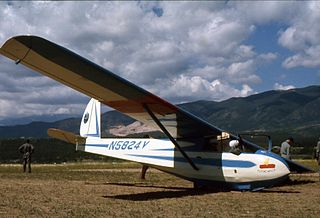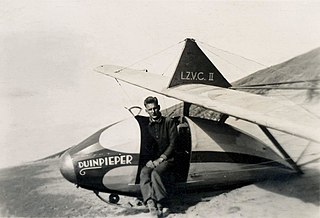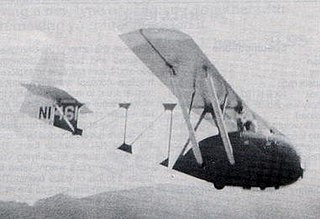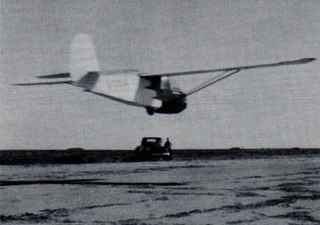
The Schweizer SGU 1-7 is an American Open Class, single-seat, high-wing strut braced glider built by Schweizer Metal Aircraft Company of Elmira, New York.

The Schweizer SGS 2-8 is an American two-seat, mid-wing, strut-braced, training glider built by Schweizer Aircraft of Elmira, New York.
The Schweizer SGU 1-19 and Schweizer SGU 1-20 are a family of United States single-seat, high-wing, strut-braced, utility gliders built by Schweizer Aircraft of Elmira, New York.

The Schweizer SGU 2-22 is an American two-seat, high-wing, strut-braced, training glider built by Schweizer Aircraft of Elmira, New York.

The T.31 Tandem Tutor is a British military training glider, designed and built by Slingsby and used in large numbers by the Air Training Corps between 1951 and 1986.

The Bowlus/Nelson BB-1 Dragonfly is an American, two seat, strut-braced, high-wing motor glider that was developed from the Bowlus BA-100 Baby Albatross glider by Hawley Bowlus.

The Franklin PS-2 is an American, high-wing, strut-braced, single seat, glider that was designed by R. E. Franklin and produced by the Franklin Glider Corporation starting in 1930.
The Scanlan SG-1A is an American, single seat, pod-and-boom, high-wing, strut-braced glider that was designed by Thomas W. Scanlan in 1970 and sold in the form of plans for amateur construction.

The Bock 1 is an American high-wing, strut-braced single-seat glider that was designed by John W. Bock of Long Beach, California.
The Cadet UT-1 is an American single-seat, high wing, strut-braced glider modified by Alex Dawydoff from the original Slingsby Kirby Cadet design and produced by Cadet Aeronautics.
The Bennett-Carter CBS-1 Dottie S is an American high-wing, strut-braced single-seat glider that was designed by George Bennett and Richard Carter and first flown in 1958.

The Zögling is a German high-wing, cable-braced, single seat primary glider that was designed by Alexander Lippisch in 1926 and produced with many variations by a variety of manufacturers.

The Haufe Dale Hawk 2 is an American high-wing, strut-braced, single-seat glider that was designed and built by Walter Haufe and Leland Hanselman.

The Jongblood Primary is an American single-seat, high-wing, strut-braced primary glider designed by Mike Jongblood of southern California and first flown in 1967. The aircraft is unusual in that primary gliders went out of fashion in the 1930s and few have been built since.

The Kennedy K-W is an American high-wing, strut-braced, single-seat glider that was designed by Harold Kennedy of Dodge City, Kansas, with assistance from Floyd Watson. The aircraft is notable for being assembled from certified powered aircraft components and also for having had an in-flight break-up.

The Midwest MU-1 was an American single-seat, high-wing, strut-braced utility glider that was designed by Arthur B. Schultz in the 1930s.
The Schultz Nucleon is an American high-wing strut-braced, single-seat glider that was designed and constructed by Arthur B. Schultz.

The Schleicher Condor, also referred to as the Dittmar Condor, is a series of German high-wing, single and two-seat, gull winged, gliders that were designed by Heini Dittmar in the 1930s, produced in small quantities before the Second World War, produced again between 1952 and 1955 by Alexander Schleicher GmbH & Co and also by Ferdinand Schmetz.
The Kelsey K-16 is an American, strut-braced, high-wing, two-seat, glider that was designed and constructed by William Frank Kelsey of Salt Lake City, Utah.
The Gross Sky Ghost is an American high-wing, strut-braced, two-seat, glider that was designed by Frank R. Gross.














